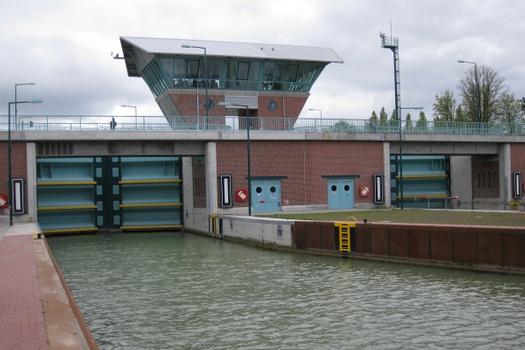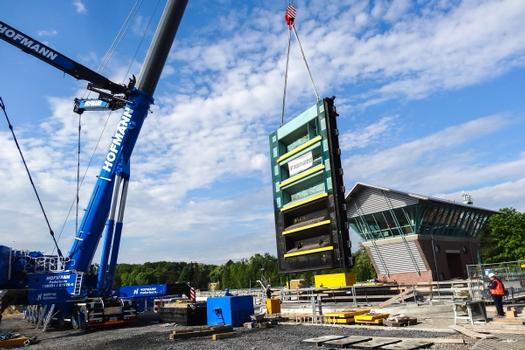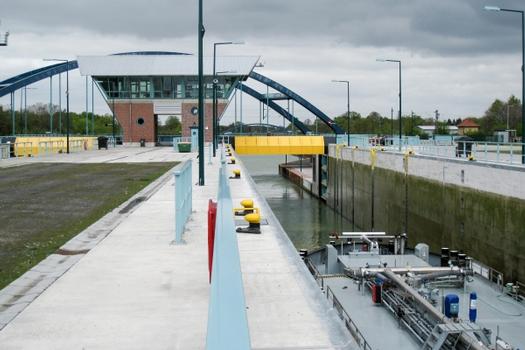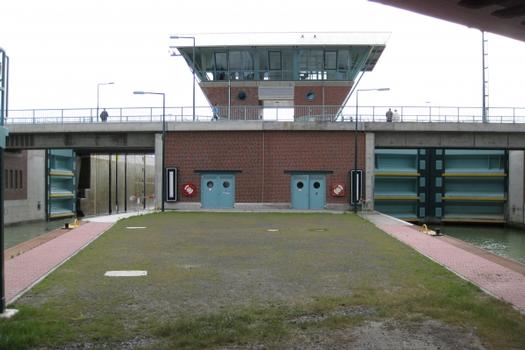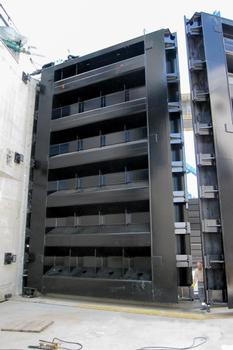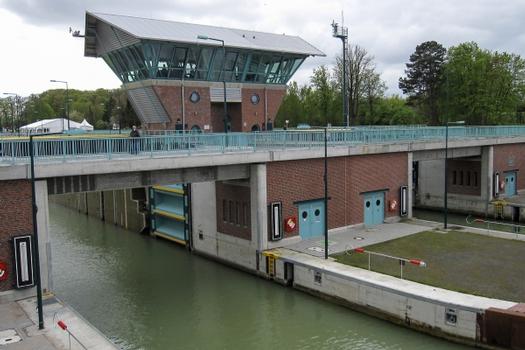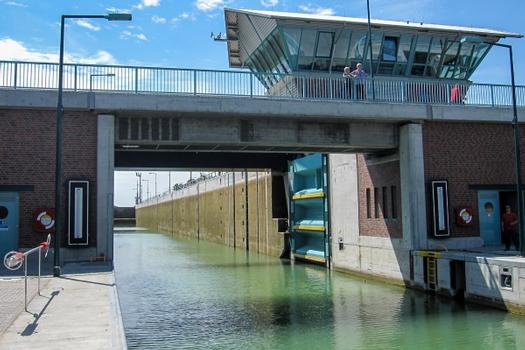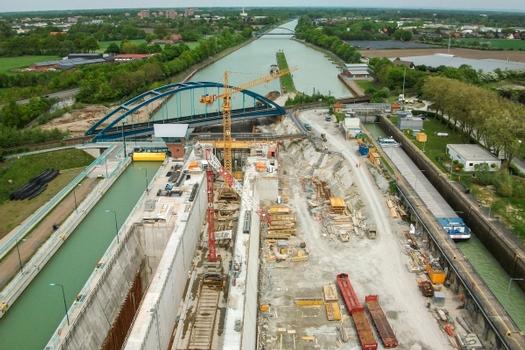General Information
Project Type
| Structure: |
Trough / U-shaped retaining structure |
|---|---|
| Function / usage: |
Lock |
Awards and Distinctions
| 2015 |
entry
for registered users |
|---|
Location
| Location: |
Münster, North Rhine-Westphalia, Germany |
|---|---|
| Part of: | |
| Next to: |
Münster Lock (1926)
|
| Replaces: |
Münster Lock (1898)
Münster Lock (1913) |
| Coordinates: | 51° 58' 42.20" N 7° 39' 41.57" E |
| Coordinates: | 51° 58' 42.63" N 7° 39' 43.11" E |
Technical Information
Dimensions
| lock chamber 1 | width | 12.5 m |
| length | 190 m | |
| height difference | 6.2 m | |
| lock chamber 2 | width | 12.5 m |
| length | 190 m | |
| height difference | 6.2 m |
Materials
| trough |
reinforced concrete
|
|---|
New twin lock Münster — machinery and steel hydraulic components of the plant
Task definition
Due to the age of the 3 old locks and the increased requirements from the shipping industry, the construction of 2 new locks at the Münster canal stage on the Dortmund-Ems Canal (DEK) became necessary
Eiffel Deutschland Stahltechnologie, as a partner in the joint venture „Stahlwasserbau Neue Schleusen Münster 1+2“ was commissioned by the Wasserstraßen-Neubauamt Datteln with the manufacture, delivery, erection and commissioning of the machine and hydraulic steelwork components and the hydraulic drives in 2003.
The two new locks, which will operate in twin mode after completion, will replace the two oldest locks built in 1898 and 1912.
The new Münster 1 lock was commissioned in February 2009 and with the completion of the Münster 2 lock in February 2014, the two locks will operate in twin mode. Lock 3, which was completed in 1926, has only been taken out of service for the time being.
Description of the construction
The two lock chambers, with a usable chamber length of 190 m and a usable chamber width of 12.50 m, have a lift height, i.e. overcome a gradient, of 6.20 m.
The „water consumption“ per lock operation is 15,500 m³ and in intelligent twin operation this consumption is reduced to 8,000 m³.
The lock chamber was built conventionally as a flexurally rigid, open frame using jointless construction. It is divided from the headwater toward the tailwater into 18 chamber blocks separated by space joints. The various structural steelwork components are distributed over these chamber blocks. Starting from the headrace towards the tailrace, these are, in order:
- The headrace with the head gate (hinged gate) as the closure body against the headwater and the upstream dam beam
- .
- The longitudinal channel closures and the drive units on the headrace are located in block 1
- .
- The connecting structure in block 10 with the two connecting canals connects the two locks via the connecting canal gates and enables twin operation
- .
- The longitudinal canal closures and the drive units at the lower head are located in block 13
- .
- The lower head with the lower gate (2 stem gate wings of folding structure) as the closure body against the tailwater and the downstream dam beam
An impact protection system in front of the lower gate with a working capacity of 2 MJ (megajoules) prevents major damage in the event of possible ship strikes against the lower gate.
Choice of construction materials
The supporting structure of the closure was made of general structural steels S235J2+N or S355J2+N. The fixed parts, such as running and guiding devices and the bearing parts, were made of the general structural steels, quenched and tempered steels in combination with the stainless steels (1.4301; 1.4541; 1.4571; 1.4418; 1.4462 and 1.4057). The guards and deflectors are made of thermoplastics, and the seals are made of synthetic rubber.
Special engineering achievement
On August 11, 1899, Kaiser Wilhelm II opened the Dortmund-Ems Canal, and this opening fulfilled the centuries-old dream of connecting Westphalia with the North Sea. At the same time, the Dortmund-Ems Canal was the first section of a large-scale Rhine-Weser-Elbe link planned by the Prussian government and paved the way for the economic boom in northwestern Germany. The construction of the canal brought about structural change in the regions, which were now located directly on a waterway.
The lock facilities were designed as industrial structures, through creative processes to become objects of engineering and a contribution to building culture. Many lock structures were integrated into their surroundings by adapting the structure, such as using region-specific materials. The free-time use of waterways dictates landscape integration and design.
Many lock structures that are still in operation today after more than 100 years combine architectural design with high serviceability. The new Münster 1 and 2 locks will also later be objects of architectural culture.
An essential prerequisite for this is the retention of traditional construction methods in the design, manufacture and assembly of the steel hydraulic components, with the integration of new but proven materials and components. The old constructions have distinguished themselves through particular robustness and durability; the new constructions are to be at least as durable through the engineering combination of the tried and tested coupled with the new.
Longevity has the positive effect that the technical service life of hydraulic structures is 80 to 100 years. The robust design ensures trouble-free operation and guarantees high availability of the plant.
This robustness and high availability in steel hydraulic engineering is not coincidental, as the highest accuracy requirements are placed on the running and guiding devices, track rollers and metallic seals of the roller wedge gates. These mechanical engineering components were mechanically machined and manufactured and assembled to within tenths of a millimeter. Control by measurement was performed during manufacturing and assembly by 3D laser measurement technology.
Explanatory report by Eiffel Deutschland Stahltechnologie GmbH for submission to the Ulrich Finsterwalder Ingenieurbaupreis 2015
.
Participants
Relevant Web Sites
There currently are no relevant websites listed.
- About this
data sheet - Structure-ID
20066634 - Published on:
01/12/2014 - Last updated on:
01/12/2014

